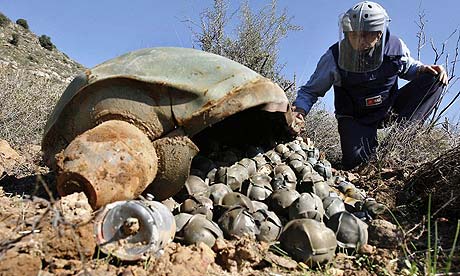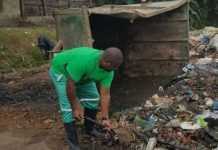SHE was only six years old in 1998 when she suffered a tragic accident that left part of her right leg maimed in an explosion.
22-year-old Aynalem Zenebe of Ethiopia, who today is aided by an artificial leg, was at school when the incident happened.
“I was only six years old when my school was bombed. On that day, my younger brother, two of my sisters and I were all injured,” she recalled.
Like many other survivors, she had to undergo various surgical interventions and needed a lot of time to recover.
“I spent more than five months at the rehabilitation centre in Addis Ababa, away from school, from my friends and family, and like many child survivors, I had to regularly go to the hospital to check my prosthesis (artificial leg) as I was growing up,” she added.
Luckily for Aynalem, there was a rehabilitation centre within her locality, but this is not the case for many other survivors residing in remote corners of Ethiopia and other isolated areas around the world.
Young as she may be, Aynalem, is alive to the fact that the impact of cluster munitions goes far beyond individual survivors, because they affect families and communities as well.
A similar story is that of Margaret Orech of Uganda, whose planned Christmas vacation of 1998 would always be a memorable one not because it was one of the most joyful celebrations, but because this period changed the course of her life, giving it a totally different dimension.
For Ms Orech, her ideal way of spending Christmas that year was to travel with her family to her home village in northern Uganda.
Unfortunately for her and three others she was travelling with, their vehicle hit a land-mine which exploded, leaving them seriously injured.
Ms Orech, lost part of her right leg below the knee, and currently has an artificial leg.
Today, Ms Orech who is now director at the Uganda Landmine Survivors Association (ULSA), is also one of the Ambassadors for the International Campaign to Ban Landmines (ICBL), is also a campaigner for the Cluster Munition Coalition (CMC).
She has been an ardent advocate calling on her country to ratify the convention which they have already signed.
Cluster munitions overwhelmingly affect civilians including women and children as major victims.
Moaffak Alkhafaj from Iraq is a survivor of cluster munitions used during the 1991 Gulf war.
At the time, he was working in a military camp, which was attacked by some insurgents.
The explosion left part of his left leg mutilated.
“I used to participate in a lot of sporting activities, including horse riding, but the accident left me very traumatised because I did not know what would become of me,” he narrated.
Today Mr Alkhafaj works to ban cluster bombs globally because of the anguish they cause in the lives of survivor victims.
His plea to is that as many countries as possible join the Convention on Cluster Munitions (CCM), whose presidency is now being held by Zambia, to ensure the rights of survivors and prevent further suffering caused by this indiscriminate weapon.
CMC spokesperson Branislav Kapetanovic was injured by a cluster bomb while serving in the Serbian military.
For him, the memories of November 9, 2000, would forever remain fresh because he lost all four limbs (hands and legs) in a split second.
He met his fate in the year 2000, when he was on-duty working on a project to de-mine an area affected by explosive weapons, about 300 kilometers from Belgrade-the Serbian capital.
“I was working as a de-miner, and was tasked to clear one of the contaminated areas, in a split second, all I can recall was a big explosion, after which I could not see anything. I actually thought I was blind,” he recalled.
“I remember that although I could hardly hear or see anything, I could still speak because I was conscious, shouted for help and my fellow soldiers who came to my rescue did not know how exactly to handle me because I was in really bad shape,” he said.
Mr Kapetanovic, whose accident was nearly fatal had to be rushed to one of the major hospitals in Belgrade, where he spent the next four years of his life under-going various surgical interventions to ensure his survival.
He under-went 25 different surgical operations.
Serbia has not joined the convention but luckily for him, because he was a military officer, the cost of treatment were fully covered by the Government. Countries that join the convention on cluster munitions must ensure assistance to victims.
Because of the intensity of his injuries, it was evident that Mr Kapetanovic could no longer continue serving in the army, and therefore was granted early retirement on medical grounds.
According to Mr Kapetanovic, Serbia still has a lot of stock-piles of cluster munitions which he said required as much as US$ 2 billion to completely destroy. Destruction of weapon stock-piles is one of the key provisions of the convention, along with support for international cooperation to do so.
“Africa can have a leading role in convincing other countries in the world to join the convention. With Zambia holding the presidency, I believe it can lead Africa to become the first continent in the world to become free of cluster munitions and others will also be inspired to join the convention. I believe all countries can and should join the convention,” he said.
112 countries worldwide have already signed or acceded to the 2008 CCM.
One of the most recent countries to become a full member of the convention is Iraq, which ratified the treaty in April this year.
Iraq Minister of Environment Sargon Lazar Slewa, who is participating in the meeting this week, explained that his country was one of the most polluted in the world by cluster munitions.
He said the cluster munitions in Iraq came as a result of the many wars and civil strifes the country has experienced citing the Gulf War, and 2003 as the major ones.
In congratulating the Zambian Government for assuming the CCM presidency, Mr Slewa said his government appreciated Zambia being the first African country to host this high level meeting, and that the rest of the world was looking forward to positive out-comes.
Ms Orech’s plea is to regional bodies like the East African Community (EAC), the Southern African Development Community (SADC) and the African Union (AU) to ensure that the members signed and joined the convention and to place the African continent as a leader in riding the world of the use, production and stock-piling of cluster munitions.
Cluster munitions or cluster bombs by definition are weapons containing multiple, often hundreds of small explosive sub-munitions or bomblets.
These are often dropped from the air or fired from the ground and are designed to break open in midair, releasing the sub-munitions all over areas as large as several football fields.
Literally, this means that these weapons do not discriminate between military personnel, (who are usually the prime targets) and civilians.
History has shown that many of the sub-munitions have failed to explode on impact and instead remain a threat to livelihoods and environments for decades long after a conflict.
Over the years, a lot of innocent victims mostly civilians have been maimed after falling victim to these weapons exploding unexpectedly.
According to the 2013 Cluster munition monitor report, the convention’s disarmament provisions prohibit the use, production, transfer and stockpiling of cluster munitions, as well as any assistance with any banned activities, by requiring that stockpiled cluster munitions be destroyed within eight years.
For now, this goal may seem ambitious to achieve, but with commitments being made by governments, coupled with the necessary legislations to back this, Africa may just become a shining example to the rest of the world.

 JOIN DRIVERN TAXI AS PARTNER DRIVER TODAY!
JOIN DRIVERN TAXI AS PARTNER DRIVER TODAY!











